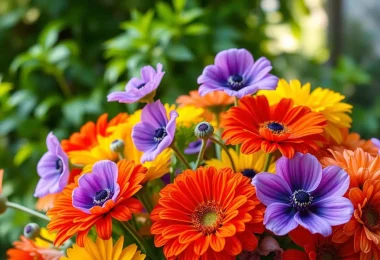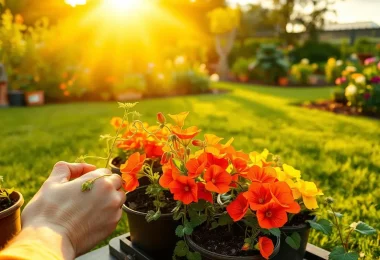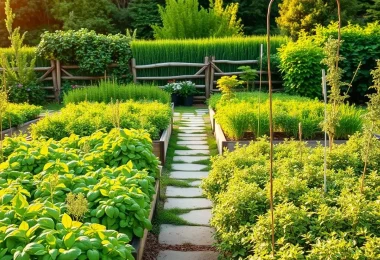A raised bed in your garden can greatly improve soil quality. It’s perfect for growing a thriving vegetable or flower garden. You can control the soil and drainage, giving your plants the best chance to thrive. This guide will help you through every step, from choosing the right spot to harvesting your crops.
Whether you’re new to gardening or have experience, a raised bed is a great addition. It lets you plant a variety of flowers, vegetables, and herbs in a controlled space. By following this guide, you’ll learn how to plan, build, and maintain your raised bed garden. You’ll enjoy the many benefits of having a raised bed in your garden.
Introduction to Raised Bed Gardening
Raised bed gardening is a popular method that involves growing plants in a raised bed. These beds are usually made of wood, metal, or composite materials. This type of gardening offers many benefits, including better soil quality, drainage, and crop yields.
By using a raised bed, you can create a customized growing environment. This environment meets the specific needs of your plants. You’ll enjoy a bountiful harvest of fresh fruits and vegetables.
Key Takeaways
- Improved soil quality and drainage with a raised bed
- Increased crop yields and better plant growth
- Customized growing environment for specific plants
- Easier to care for and maintain than traditional gardens
- Perfect for beginners and experienced gardeners alike
- Raised beds can be made from a variety of materials, including wood and composite options
Benefits of Adding a Raised Bed in Garden
A well-designed raised bed garden can greatly enhance any outdoor space. It offers many benefits for gardeners. One key advantage is better drainage, which prevents waterlogged soil and root rot. This is crucial in areas with heavy rainfall or poor soil.
By adding a raised bed, you can create a space that is both functional and beautiful. It meets your needs and improves your gardening experience.
Some main benefits of raised bed gardens include:
- Warmer soil, which can extend the growing season
- Easier access to plants, reducing strain on your back and knees
- Improved soil quality, as raised beds can be filled with a custom mix of soil and amendments
- A clear definition between different areas of the garden, making it easier to maintain and care for your plants
When planning a raised bed garden, think about the look you want. You can use materials like wood or composite to make it unique and useful. Adding a raised bed to your garden design makes it beautiful and functional. It meets your needs and boosts your gardening joy.
Planning Your Raised Bed Garden
Planning is crucial for a thriving garden. A well-planned raised bed garden can greatly impact your plant’s success. First, think about the sunlight your plants need and how easy it is to reach the area. This will help you pick the perfect spot for your raised bed.
A raised bed can expand your gardening space. You can try many designs, from simple to complex. Using recycled materials, like old pallets or bricks, can make your garden unique and eco-friendly.
When choosing the size and height of your raised bed, think about the plants you want to grow. Some, like tomatoes and peas, need a lot of room. Others, like herbs and lettuce, do well in smaller spaces. Here are some key factors to consider:
- Sunlight: Most plants need at least 6 hours of direct sunlight daily.
- Soil: You can use garden soil, compost, or potting mix in raised beds.
- Water: Adding irrigation systems, like drip irrigation or soaker hoses, can make watering easier.
By planning your raised bed garden carefully, you can create a beautiful and useful space. It’s great for both experienced gardeners and beginners. A raised bed garden can add to your yard’s space and bring many gardening benefits.
Essential Materials and Tools Needed
Building a raised bed garden needs the right materials and tools. This ensures a successful gardening experience. You’ll need wood, soil, and plants, along with tools like a shovel, rake, and trowel.
Here are the essential materials and tools for your raised bed garden:
- Wood or other building materials for the frame
- Soil and compost for filling the bed
- Plants of your choice, such as vegetables, herbs, or flowers
- A shovel for digging and moving soil
- A rake for leveling and smoothing the soil
- A trowel for planting and watering
Having these materials and tools ready will make building and maintaining your garden easier.
Investing in quality materials and tools is key. This way, your raised bed garden will thrive, giving you fresh produce and beauty for years. Choose materials and tools that can handle the weather and last long.
Selecting the Right Building Materials
Choosing the right materials for your raised bed garden is key. The design should be strong, last long, and be good for the environment. You can pick from wood, metal, or composite materials. Each has its own benefits and drawbacks, depending on your budget, taste, and eco-friendliness goals.
A good design considers the cost and how long each material lasts. Wood is liked for its natural feel but needs more care. Metal and composite materials are stronger and easier to keep up, but cost more. Thinking about these points helps you pick the best material for your garden.
Material Options
- Wood: a natural, rustic option that can add a touch of warmth to your garden
- Metal: a durable, low-maintenance option that can withstand harsh weather conditions
- Composite materials: a sustainable, eco-friendly option that can mimic the look of wood
Your raised bed garden’s design should show your style. By picking the right materials, you can make a garden that looks great and works well for years.
Building Your Raised Bed Structure
Creating a raised bed is an exciting project that can enhance your gardening experience. First, clear the area of debris and level the ground. This ensures a stable foundation for your raised bed. Use durable materials for the frame to withstand weather.
A well-constructed raised bed offers ample space for plants to grow. It improves soil quality and reduces erosion. By adding a raised bed, you create a thriving ecosystem for various plants.
Building a raised bed has many benefits. It improves drainage, soil structure, and makes gardening easier. Start by gathering materials like wood, soil, and plants. Follow a simple guide to get started.
When building your raised bed, remember to focus on drainage and aeration. Add gravel or perlite at the bottom for better drainage. Use a mix of topsoil, compost, and organic matter for nutrient-rich soil. These tips will help you create a beautiful and functional raised bed.
Popular materials for raised beds include cedar, recycled plastic, and composite wood. Each has its own benefits and drawbacks. Research and choose the best material for your needs. With planning and creativity, you can build a raised bed that enhances your garden.
Preparing the Ground Foundation
Starting a raised bed in your garden needs a solid base. First, clear and level the spot for your bed. Get rid of debris, rocks, and weeds. They can harm your plants and the bed’s structure.
A good ground foundation is key for a raised bed’s success. It gives your plants the right nutrients and water. It also keeps weeds out of your bed. Use a weed barrier to stop weeds from competing for resources.
Clearing and Leveling the Area
- Remove any debris, rocks, or weeds from the area
- Level the ground to ensure it’s even and flat
- Check for any underground utilities or obstacles
Installing Weed Barrier
Putting in a weed barrier is easy and effective. It keeps weeds out of your raised bed. This makes your garden more eco-friendly and cuts down on chemical use.
Creating the Perfect Soil Mix
Designing a raised bed garden starts with the soil mix. A balanced mix is key for plant growth. It needs nutrients, water, and air. To get it right, mix topsoil, compost, and organic matter.
This mix creates a healthy space for your plants. It’s the heart of a good raised bed garden.
A good mix includes:
- Topsoil: gives plants a solid base
- Compost: adds nutrients and improves soil
- Organic matter: keeps moisture in and weeds out
These elements make your garden special. They meet your plants’ needs.
Don’t forget about soil pH and nutrients. You might need fertilizers or other helpers. A balanced mix means a successful garden. You’ll get lots of fresh produce and flowers.
Installing Irrigation Systems
Keeping a raised bed garden healthy needs a good irrigation system. Raised beds dry out fast because they’re higher up. A good system saves water, cuts down on evaporation, and keeps plants moist.
Drip irrigation is great for raised beds. It waters plants right at their roots. This method cuts down on water lost to runoff and evaporation. To set it up, you’ll need to lay out tubes and drippers across your bed.
Drip System Setup
- Choose a drip irrigation kit made for raised beds
- Follow the maker’s guide to install the tubing and drippers
- Check the system works right and tweak it if needed
Water Conservation Tips
There are ways to save water in your garden too. Use rain barrels to catch and save rainwater. Mulch helps keep the soil moist by blocking evaporation. These steps help your garden use less water and be kinder to the planet.
With these tips and a smart irrigation system, your raised bed garden will flourish. Keep an eye on your plants’ water needs and tweak your system to get the best results.
Choosing Plants for Your Raised Bed
Choosing plants for your raised bed can be tough. But with some planning, you can make a garden that’s full of life and fresh food. Raised beds let you control the soil and conditions for your plants.
First, think about your area’s climate and sunlight. Most veggies and herbs need at least 6 hours of sun a day. Flowers and ornamentals might need different amounts. Knowing what your plants need helps you pick the right ones for your garden.
- Vegetables: tomatoes, cucumbers, carrots, and lettuce
- Herbs: basil, mint, cilantro, and parsley
- Flowers: marigolds, zinnias, sunflowers, and daisies
Companion planting is key when picking plants for your garden. Pairing plants that help each other can make your garden better. For instance, marigolds with tomatoes can fight nematodes. Basil and mint can also make nearby veggies taste better.
Planting Techniques and Spacing
Creating a thriving design for raised bed garden starts with the right planting techniques and spacing. The method you choose depends on the plant type, climate, and soil. For example, plants needing full sun should get at least 6 hours of direct sunlight.
Spacing is key to avoid overcrowding and disease. Leave 1-2 inches between each plant, based on their size. This ensures they have room to grow and get enough air.
Here are some tips for your raised bed garden:
- Plant taller plants towards the north to avoid shading smaller plants
- Use a mix of plants with different growth habits to create a visually interesting garden
- Consider using a trellis or other support system for plants that need it
By following these tips and considering your plants’ needs, you can make a healthy design for raised bed garden. This garden will give you fresh produce and beautiful flowers. Always check the specific spacing and planting needs for each plant you include.
Maintaining Your Raised Bed Garden
To keep your raised bed garden thriving, regular maintenance is key. This includes tasks that help your plants grow well. A well-maintained raised bed can give you a great harvest and beautiful flowers.
Important parts of raised bed care include seasonal care tips like pruning and dividing plants. These steps keep plants healthy and growing well. Also, pest management is vital to protect your plants and keep yields high. A fertilizing schedule helps provide the nutrients your plants need.
Seasonal Care Tips
- Prune plants regularly to maintain shape and promote healthy growth
- Divide plants to prevent overcrowding and encourage new growth
- Monitor soil moisture levels to prevent overwatering or underwatering
Pest Management
Common pests in raised bed gardens include aphids, slugs, and snails. Use organic methods like introducing beneficial insects or physical barriers to manage them. Check your plants often to catch problems early and act quickly to prevent damage.
Fertilizing Schedule
A fertilizing schedule is important for your plants’ growth. Use a balanced fertilizer and follow the instructions for how much and when to apply. This will help your plants grow strong and give you a good harvest.
Common Challenges and Solutions
Creating a raised bed in your garden can face some challenges. Pests, diseases, and nutrient deficiencies are common problems. To avoid these, use organic pest control, keep your garden clean, and ensure your plants get the nutrients they need.
Pests like aphids, whiteflies, and spider mites can be a big issue. To fight them, try introducing beneficial insects, spraying soap solutions, or using neem oil. Diseases can also be a problem. To prevent them, make sure there’s good air flow, remove sick plants, and use fungicides.
Nutrient deficiencies can harm your plants. To prevent this, use a balanced fertilizer and test your soil often. By being proactive, you can keep your raised bed healthy and thriving.
Some solutions to common challenges in a raised bed in garden include:
- Using organic pest control methods to prevent pest infestations
- Practicing good sanitation and hygiene to prevent disease
- Providing plants with necessary nutrients to prevent nutrient deficiencies
By following these tips and being proactive, you can overcome common challenges and enjoy a successful and thriving raised bed in garden. Always watch your garden’s condition and act quickly if you see any problems. With the right care, your raised bed can be a beautiful and productive space.
Extending Your Growing Season
Wondering how to make your raised bed garden last longer? A well-designed garden can give you more time to grow. It’s all about planning for your plants’ needs.
Think about using cold frames and row covers to keep plants warm. These tools create a cozy spot for your plants to grow.
Here are some ways to make your growing season longer:
- Choose plants that can handle frost and cold.
- Give plants extra light to make days seem longer.
- Use cold frames and row covers to shield plants from harsh weather.
With these strategies, your garden can thrive all year. You’ll get to enjoy fresh food and beautiful flowers, even in winter. Your garden will be a haven, no matter the season.
Conclusion
Creating a thriving raised bed garden needs careful planning and maintenance. But the rewards are worth it. You’ll enjoy fresh vegetables, herbs, and flowers that make your meals and garden beautiful.
The raised bed is great for small spaces and lets you tailor your garden. This guide helps both new and experienced gardeners. It shows how to set up a raised bed in your garden and enjoy its benefits for years.
Start your raised bed gardening journey with excitement and a willingness to learn. With the right approach and patience, your garden will grow. It will become a special part of your outdoor space.
FAQ
What are the benefits of adding a raised bed to my garden?
A raised bed improves soil quality and drainage. It also warms the soil and makes it easier to reach your plants. This setup helps define different garden areas, making maintenance simpler.
How do I choose the perfect location for my raised bed?
Choose a spot with the right sunlight and easy access. The area should get enough sun for your plants and be simple to reach for upkeep and harvesting.
What materials should I use to build my raised bed?
You can use wood, metal, or composite materials for your raised bed. Each has its own advantages and disadvantages. Think about your budget, preferences, and environmental impact when picking materials.
How do I create the perfect soil mix for my raised bed?
For a thriving garden, mix topsoil, compost, and organic matter. Add fertilizers and amendments for extra nutrients. A balanced mix ensures your plants get what they need for growth.
How do I choose the right plants for my raised bed garden?
Choose a mix of vegetables, herbs, flowers, and ornamentals that fit your climate. Companion planting boosts your garden’s productivity and diversity.
How do I maintain my raised bed garden?
Regular care is key for a healthy garden. Follow seasonal tips, manage pests, and fertilize consistently. This keeps your garden thriving and productive all season.









